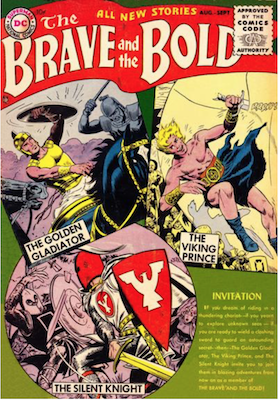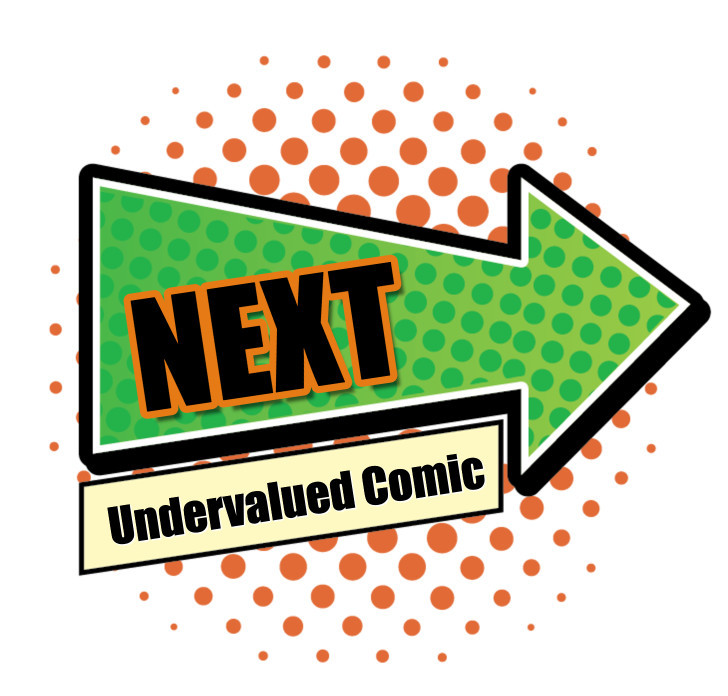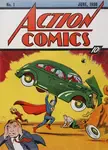Undervalued Comics: Brave and the Bold 1
Why Brave and the Bold 1 is an Undervalued Comic
As comic book collectors, we are preconditioned to seek out first issues. It’s practically hard-wired deep into the back of our lizard-geek brains.
After all, a first issue is where it all starts; it’s the one issue above all others that’s most likely to have the origins and first appearances that really bake coin into the resale cake. Of an entire series, the #1 is generally the one that matters, often the only one that matters.
But that’s not always true.
Sometimes it’s the latter issues in a series that cause dollars to come flying out of key collector wallets. And in the case of a series like DC Comics’ The Brave and the Bold, which practically overflowed with first appearances, including debuts of some of the most important characters and concepts of the Silver Age, and narrative conceits that drive DC content to this very day — well, that #1 can get entirely overlooked.
B&B, as fans like to abbreviate it, is best known as a Batman team-up title. But before that it had a period as a sort of sister-book to Showcase, with a similar “try-out” format.
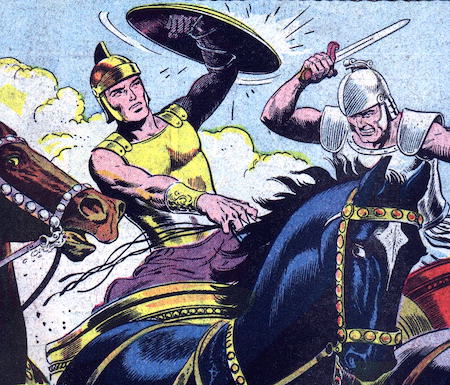 Undervalued comic books: Brave and the Bold #1, Golden Gladiator
Undervalued comic books: Brave and the Bold #1, Golden GladiatorAnd where Showcase gave the world updated versions of The Flash, Green Lantern, and The Atom, not to mention Adam Strange, Metal Men, Sea Devils, and the Challengers of the Unknown, it was B&B that delivered the Katar Hot Hawkman, the Suicide Squad, and the Teen Titans, not to mention Metamorpho and the King Kahuna of them all — the Justice League of America.
So, it may not be surprising that the early B&B issues, before its try-out phase, are so overshadowed in the marketplace. Even its first issue doesn’t get the auction love it deserves. Simply said, when taking into account rarity, quality, and historical relevance, Brave and the Bold #1 should sell for more than it does. A lot more.
But this is what happens in a market so hyper-focused on super-heroes. When it was launched on June 7, 1955, B&B was an adventure comic.
DC did not fare near as badly as its peers in the juvenile delinquency scare of the mid-1950s. Unlike other publishers, its line was diverse and kid-friendly, almost aggressively so — a fact business manager Jack Liebowitcz made sure of, given the girlie-mag pulp fiction origins of his boss, Harry Donenfeld.
Even so, change was in the air. Sure, the new Comics Code Authority helped clear the board of hard-core crime and horror comics, thereby driving many of DC’s biggest competitors from the market. But the CCA’s seal of approval was not the sales booster its proponents might have hoped for. With the stamp in place to assuage parental fears — on DC covers starting in January 1955 — parents promptly went back to mostly ignoring comics. And that put the kids back in charge.
But it wasn’t just that fans of things like Tales from the Crypt failed to pick up Peter Porkchops once the real tabasco was taken off the table. The tastes of what readers remained was changing, too. And while many kids did stick to genres tried and true, clear preferences were emerging.
All of DC’s funny animal titles were sucking wind, from Nutsy Squirrel to Raccoon Kids. That roost was increasingly rolled by Dell, whose books starred Donald Duck, Bugs Bunny, and other charactrers kids actualIy knew.
Meanwhile, DC’s teen-humor titles, like Binky and Buzzy were losing ground to Archie and the Riverdale gang. And as television took root in American homes, titles DC licensed from radio dramas, like Big Town, Gang Busters, and Mr. District Attorney, weren’t exactly lighting up the sales charts.
Things weren’t exactly dire for DC, of course. It still had Superman after all. But those three genres — funny animal, teen-humor, and radio-based crime — accounted for nearly half of the DC line. But what to substitute on the publishing schedule for titles starting to struggle?
DC must’ve felt it was already giving kids as much as they could bear in terms of western, sci-fi, and super-hero comics. Keep in mind, DC only had five super-heroes in its stable at this time. And it would’ve canceled Wonder Woman but for contractural obligations with the estate of her creator, William Moulton Marston, while Green Arrow and Aquaman hung on in Adventure Comics only by clutching to the trailing threads of Superboy’s cape.
Instead, DC took a scattershot approach in the summer of 1955. Probably inspired by the incredible coon-capped success of Davy Crockett for Disney, DC launched Legend of Daniel Boone and Frontier Fighters, an anthology with Crockett himself at center stage.
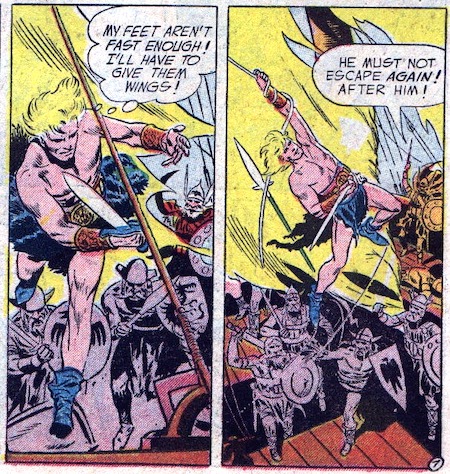 Undervalued comic books: Brave and the Bold #1, Viking Prince
Undervalued comic books: Brave and the Bold #1, Viking PrinceNeither performed, getting the chop after just eight issues. A better choice was an addition to the romance line, Falling in Love, although that was kind of a stealth add, given a total lack of DC branding on its early covers. A genuine disaster, however, was an odd little book of mostly puzzles titled, It’s Game Time. That one played for a mere four outings. And then there was The Brave and the Bold.
Many DC titles of this era had a hook. My Greatest Adventure, for example, featured tales of derring-do told in the first person. The conceit with B&B was that it spotlighted two-fisted tales set in times past. Features included the Golden Gladiator (Roman Empire), the Viking Prince (dark ages), and the Silent Knight (medieval England)
The book was edited and mostly written by Robert Kanigher, which makes sense, given that he was in kind of in a time warp already, as writer/editor of DC’s complete roster or war books, all of which remained set in World War II.
But while the war books tended to bog down in the war-is-hell trope, on B&B, Kanigher seemed to let himself go, showing flashes of the same creativity he’s later employ to create the Barry Allen version of The Flash.
The artwork in B&B was superb, among the very best of anything DC had to offer at the time, featuring Russ Heath, Joe Kubert, and Irv Novick.
Robin Hood was added to the roster with #5, at first in rotation with, but quickly displacing Golden Gladiator. Hood and Heath would then get the boot with #15, while Silent Knight would get go under the sword at #22, leaving the last two issues before the conversion to Showcase-stye try-out book entirely to Kubert and his Viking Prince.
So, while the adventure format only lasted 24 issues, those two dozen comics are truly great, as sadly under-appreciated today as they are undervalued. But, as an investor, it’s the value you care about, especially if you’re trading in slabbed comics you won’t even be able to read.
Guide to Brave and the Bold 1 Comic Book Values
- CGC 7.0 — $3,205
- CGC 6.5 — $1,361 (Sep. 2014)
- CGC 6.0 — $800 (May, 2021)
- CGC 5.5 — $780 (Sep. 2019)
- CGC 5.0 — $1,500
- CGC 4.5 — $498 (Sep. 2019)
- CGC 4.0 — $1,295
- CGC 3.5 — $419 (Jun. 2020)
- CGC 3.0 — $690 (Dec. 2021)
- CGC 2.5 — $540 (Jan. 2021)
- CGC 2.0 — $178
- CGC 1.8 — $300
- CGC 1.0 — $92 (Dec. 2020)
Getting back to value, B&B #1 is a spectacular opportunity.
For one thing, it’s not exactly common. Having been all but forgotten in the subsequent outbreak of spandex fever, B&B #1 was not generally pursued by fanboys of the Silver and Bronze Ages. And by the time comics historians started advising those fans of the gem they had missed, it was too late.
The CGC census reports just 119 copies with a universal label, plus 14 restored books, for 133 in all.
So, yeah, if you’ve got a Brave and the Bold 1 raw, in any grade, rushing it in for certification ASAP would be our best advice. Especially if it's anywhere near high grade.
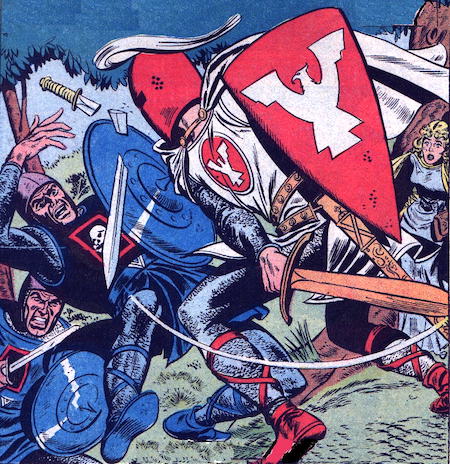 Undervalued comic books: Brave and the Bold #1, Silent Knight
Undervalued comic books: Brave and the Bold #1, Silent KnightOf the 133 copies of Brave and the Bold 1 to pass under its review, CGC has graded just two at 8.0 and one at 7.5. Every other known copy is 7.0 or lower, with most hovering around the 2.5 to 4.0 range.
There’s also this to consider — those who own this book now tend to covet it. Thus, those 133 copies don’t show up for sale all that often. CGC has graded 12 copies at 7.0, and only one of those is known to have traded hands in the past three years. It went in November 2021 for $3,205.
With no higher grades sold, that’s where GP Analysis currently tops out, which is just ridiculously low for this book, we think.
To underscore what a deal this book is, while a 5.0 sold in April for $1,500, and a 4.0 in January for $1,295, those are the only two sales of anything up to 6.5 to break the $1,000 barrier.
We really feel like a $1,000 bar should probably be set somewhere around 2.5 to 3.0. And any copy of this book graded 7.5 or better, when one sells again, should, by rights, go for five figures.
It all boils down to this: The Brave and the Bold #1 is a great book to buy. And if you can get it anywhere near the most recent sales prices listed above, then it’s a MUST-buy.
Have this book? Click to appraise its value or Consign Yours for Auction!
INDEX OF UNDERVALUED COMIC BOOKS
Related Pages on Sell My Comic Books
Brave and the Bold Comic Book Price Guide

